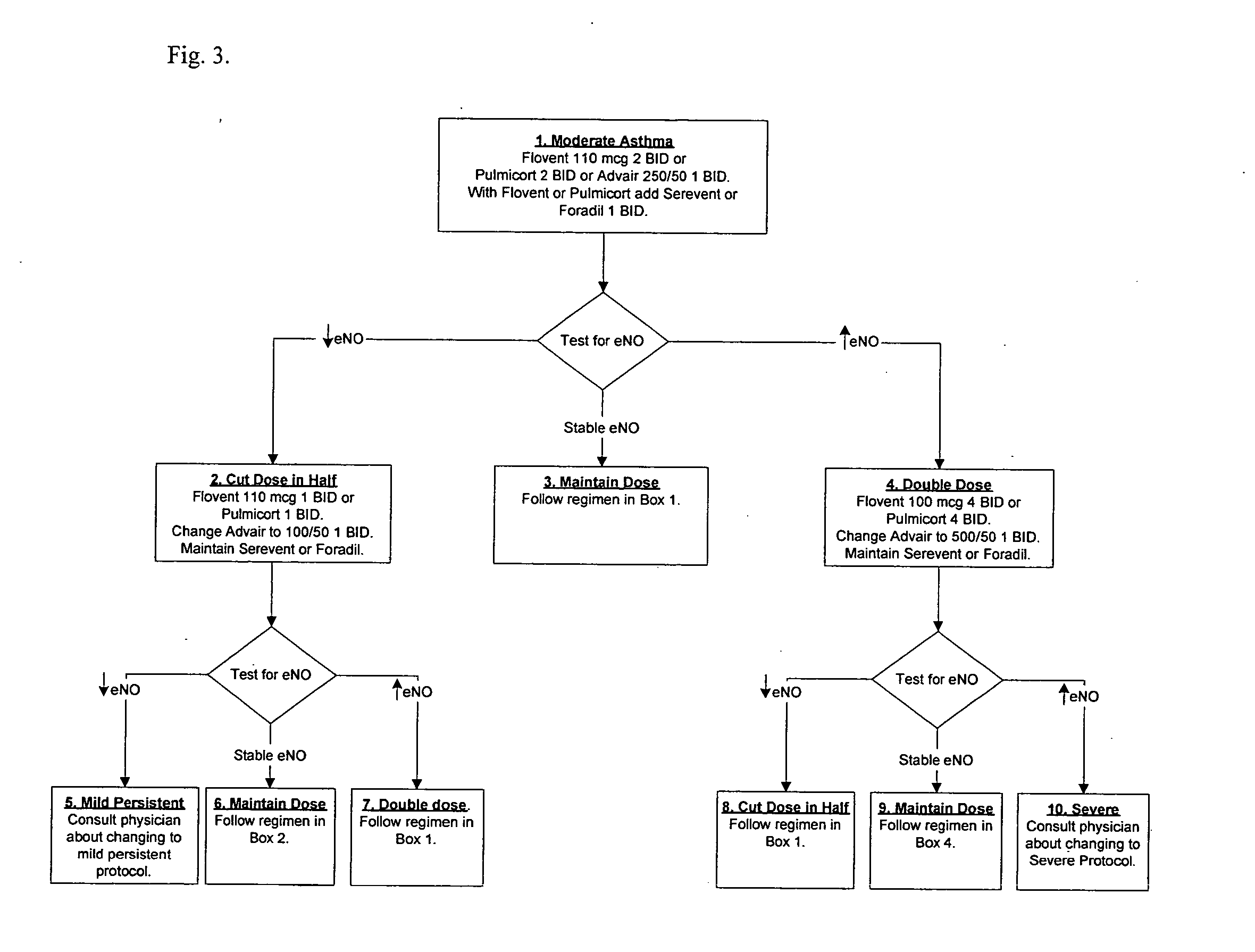Method for treating airway disorders
a technology for airways and disorders, applied in the field of airway disorders, can solve the problems of inability to exhale properly, wheezing, breathlessness, and excessive constricting of the muscles of the airways, and achieve the effects of reducing the risk of asthma, and improving the quality of li
- Summary
- Abstract
- Description
- Claims
- Application Information
AI Technical Summary
Benefits of technology
Problems solved by technology
Method used
Image
Examples
example 1
[0038] This example, a patient with “mild persistent” asthma tests his or her eNO weekly and generally follows the protocol of FIG. 2. The table below provides an exemplary timeline, with eNO readings and responsive treatments. “Box” references are to FIG. 2.
eNODay(ppb)Treatment155Pulmicort 1 BID and Serevent 1 BID for 7 days (Box 1)750Increase to to Pulmicort 2 BID (Box 4). Maintain Serevent1 BID throughout.1425Stay on course, Stable Range2120Stay on course, Stable Range2812Decrease to Pulmicort 1 QD (Box 2)3521Stay on course, Stable Range4216Stay on course, though outside Stable Range, not ≧5 ppbbelow.4912Contact physician. Stop Pulmicort and Serevent. TakeAlbuterol as needed. Restart on Box 2 regimen if higherthan Stable Range.5620Stay on course, Stable Range6325Stay on course, Stable Range7031Take Pumicort 1 QD and Serevent 1 BID
example 2
[0039] This example, a patient with “moderate” asthma tests his or her eNO every other day, and generally follows the protocol of FIG. 3. The table below provides an exemplary timeline, with eNO readings and responsive treatments. “Box” references are to FIG. 3.
eNODay(ppb)Treatment160Flovent 110 mcg 2 BID and Serevent1 BID for 7 days (Box 1)340Stay on course, appropriate trend730Stay on course, in Stable Range1542Increase to Flovent 110 mcg 4 BID for at least 1 week.Continue Serevent 1 BID throughout (Box 4).1938Stay on course, appropriate trend.2325Stay on course, in Stable Range4513Decrease to Flovent 110 mcg 2 BID for at least 1 week(Box 8 which refers back to Box 1)5525Stay on course, in Stable Range6338Increase to Flovent 110 mcg 4 BID for at least 1 week (Box4).7143Contacts physician and moves to Severe Protocol Box 1.Takes Flovent 220 mcg 2 BID. If rise continues, move updose.7548Increase to Flovent 220 mcg 4 BID7940Stay on course, appropriate trend8335Stay on course, appro...
example 3
[0040] This example, a patient with “severe” asthma tests his or her eNO every day, and generally follows the protocol of FIG. 4. The table below provides an exemplary timeline, with eNO readings and responsive treatments. “Box” references are to FIG. 4.
eNODay(ppb)Treatment180Advair 500 / 50 1 BID (Box 1)372Stay on course, appropriate trend750Stay on course, appropriate trend1042Stay on course, appropriate trend1430Stay on course, Stable Range2525Stay on course, Stable Range3137Increase dose by adding Flovent 220 mcg 2 BID andSingulair 1 QD for 7 days (Box 4).3333Stay on course, appropriate trend3728Stay on course, Stable Range4823Stay on course, Stable Range5542Contact physician. Increase dose by adding Prednisone60 mcg for 3 days only. Contact physician is eNOcontinues to rise (Box 10 and return to Box 4))5630Stay on course, appropriate trend. Prednisone should bedropped.5925Stay on course, Stable Range6815Decrease dose by dropping use of Singulair and Flovent.Continue with Advair...
PUM
 Login to View More
Login to View More Abstract
Description
Claims
Application Information
 Login to View More
Login to View More - R&D
- Intellectual Property
- Life Sciences
- Materials
- Tech Scout
- Unparalleled Data Quality
- Higher Quality Content
- 60% Fewer Hallucinations
Browse by: Latest US Patents, China's latest patents, Technical Efficacy Thesaurus, Application Domain, Technology Topic, Popular Technical Reports.
© 2025 PatSnap. All rights reserved.Legal|Privacy policy|Modern Slavery Act Transparency Statement|Sitemap|About US| Contact US: help@patsnap.com



